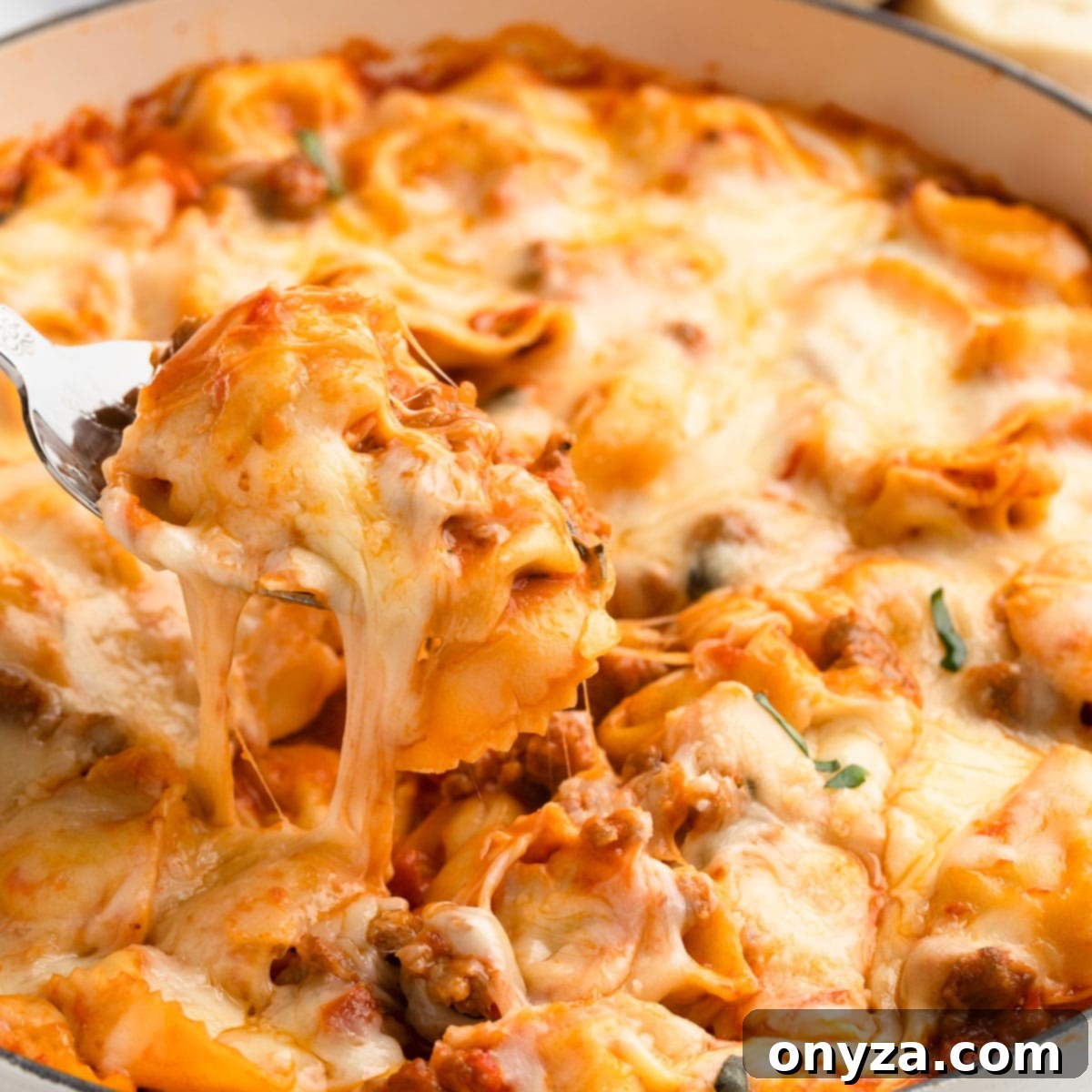Baked Tortellini with Sausage is the quintessential easy, family-favorite dinner that brings joy to any table in under an hour. Imagine tender, cheese-filled tortellini bathed in a rich marinara sauce, complemented by savory Italian sausage and the delicate creaminess of mascarpone, all crowned with a bubbling layer of golden, melted mozzarella. This dish promises comfort and flavor in every single bite.
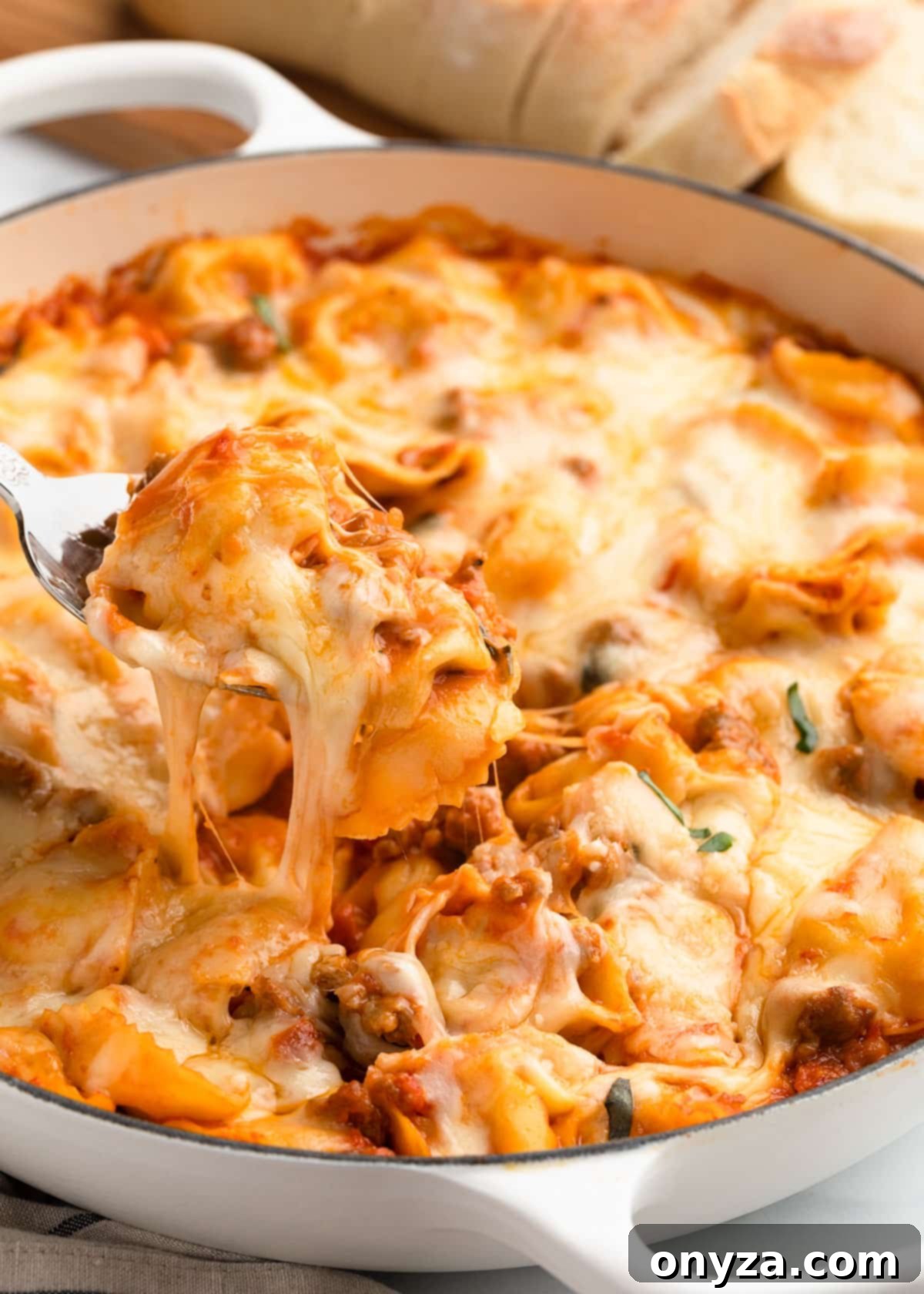
Before You Start Cooking: Key Considerations for Success
To ensure your Baked Tortellini with Sausage turns out perfectly every time, here are a few important details to keep in mind regarding your ingredients and preparation:
- This recipe is specifically designed for speed and convenience, making use of a high-quality prepared marinara sauce as its flavorful foundation. While a homemade marinara would certainly elevate the dish, a good store-bought brand is an excellent choice for those busy weeknights when time is of the essence. Prioritizing quality here will significantly impact the final taste.
- For the pasta, we recommend using refrigerated cheese tortellini or tortelloni. Tortelloni, as pictured in some sections, are generally a bit larger and offer a heartier bite compared to tortellini, but both varieties work wonderfully in this comforting bake. Choose your preference based on what’s available and what your family enjoys most.
- If you find yourself enamored with the classic combination of sausage and tortellini, you might also enjoy our Creamy Sausage Tortellini Soup – another fantastic way to savor these complementary flavors!
How to Make Baked Tortellini with Sausage: A Simple Guide to a Satisfying Meal
Creating this irresistible Baked Tortellini with Sausage is surprisingly straightforward, involving just a few key steps. Follow this detailed guide to bring a truly satisfying Italian-American classic to your dinner table.
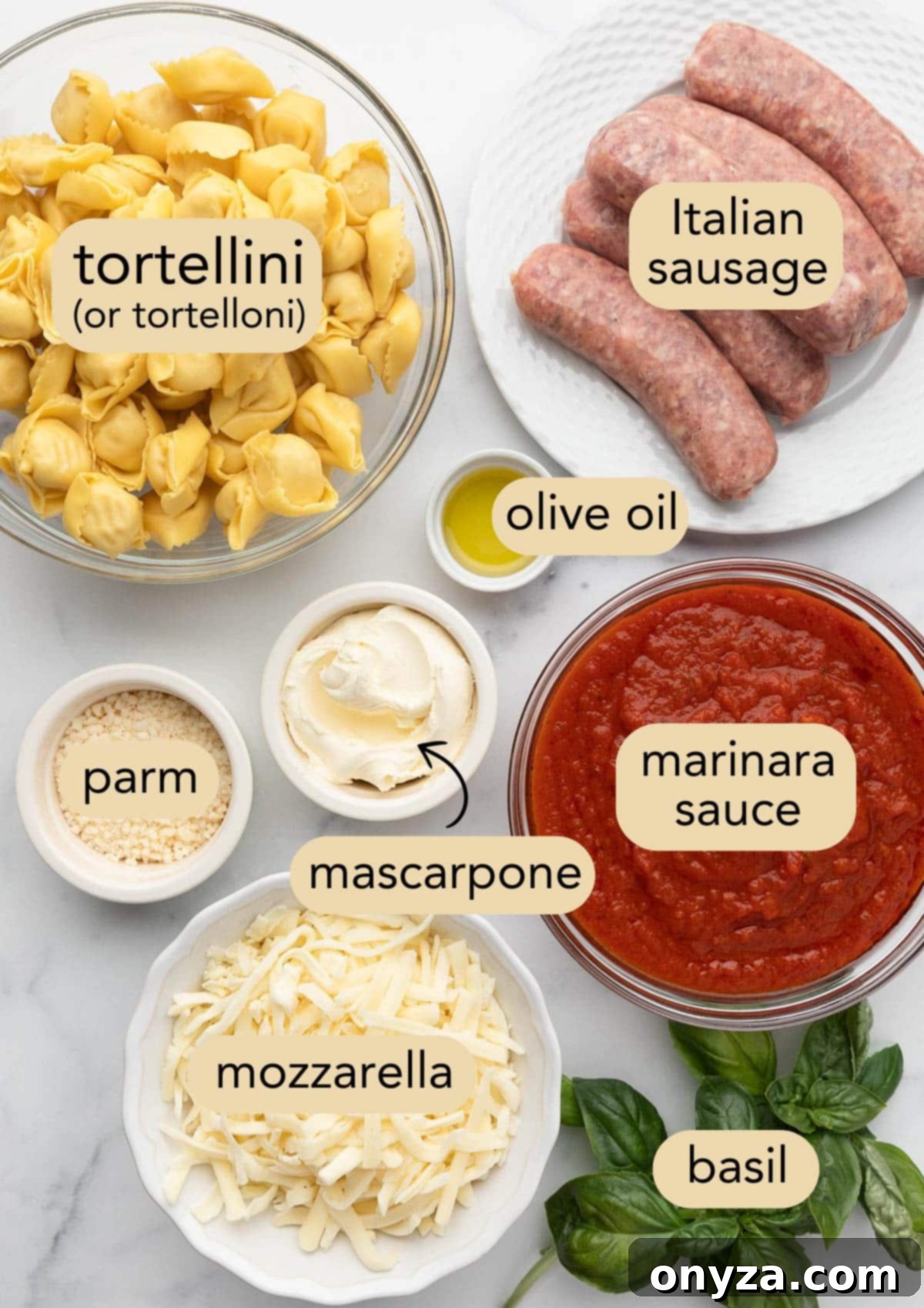
Step 1: Brown the Sausage to Perfection
The journey to a deeply flavorful baked tortellini begins with properly browning your Italian sausage. We often opt for sweet (mild) Italian sausage, typically featuring subtle fennel seeds, which imparts a lovely aromatic quality. However, if you enjoy a bit of heat, feel free to use hot Italian sausage, or even a combination of both to achieve your desired spice level.
If you’re working with sausage links rather than bulk sausage, remember to remove the casings before you begin cooking. This is easily done by making a shallow cut lengthwise down the sausage with the tip of a paring knife, then simply peeling back and discarding the casing.
To cook, heat about one tablespoon of regular olive oil in a large skillet over medium-high heat. Add the sausage meat to the hot pan and immediately begin breaking it into bite-sized crumbles using a wooden spoon or a meat masher. Continue cooking, stirring occasionally, until the sausage is fully cooked through and beautifully browned on all sides. This browning step is crucial as it develops a rich flavor that will permeate your entire dish.
Once the sausage is thoroughly cooked and browned, it’s important to drain off any excess fat from the pan. This prevents the finished sauce from becoming overly greasy and ensures a balanced texture.

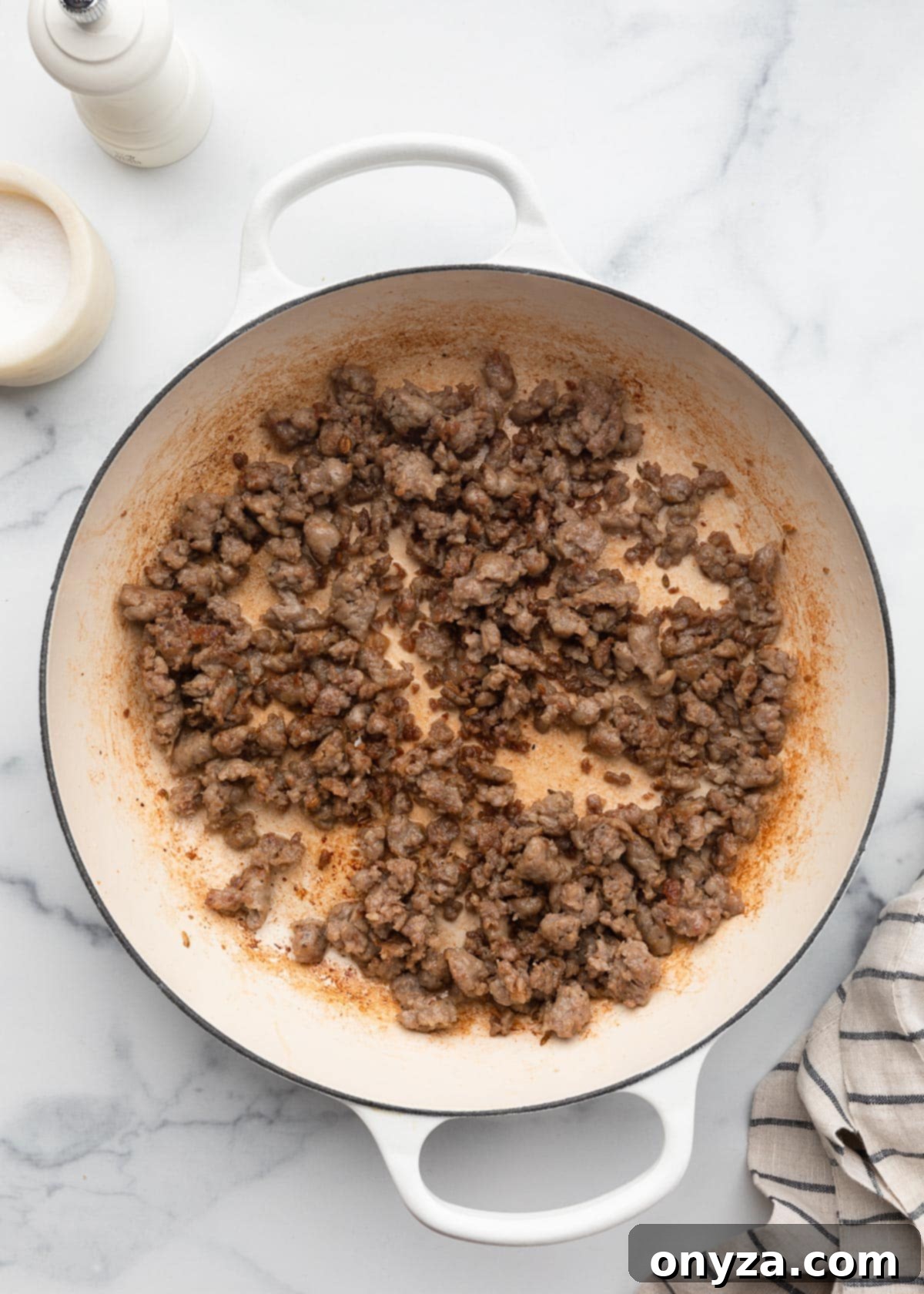
Tip: Maximizing Flavor Through Browning
Browning the sausage well isn’t just about cooking it; it’s about developing profound flavor. The golden-brown bits (known as fond) that form at the bottom of the pan are packed with deliciousness. These bits will release and enrich your sauce, adding an incredible depth, especially when using a jarred marinara. Don’t skip this crucial step!
Step 2: Crafting the Creamy Marinara Sauce
With your sausage beautifully browned, it’s time to build the heart of this dish: the rich and creamy marinara sauce. Pour approximately 3 cups (or 24 ounces) of your chosen marinara sauce directly into the skillet with the cooked sausage. Next, add about half a cup of creamy mascarpone cheese and a handful of fresh basil leaves, roughly torn to release their aromatic oils.
The mascarpone cheese is a game-changer here. It transforms the marinara into a luxuriously creamy, slightly pink sauce without making it overly thin or excessively rich. Stir the mixture gently over medium-low heat, allowing the mascarpone to melt smoothly and fully integrate into the sauce. This creates a wonderfully velvety texture that coats the tortellini beautifully.
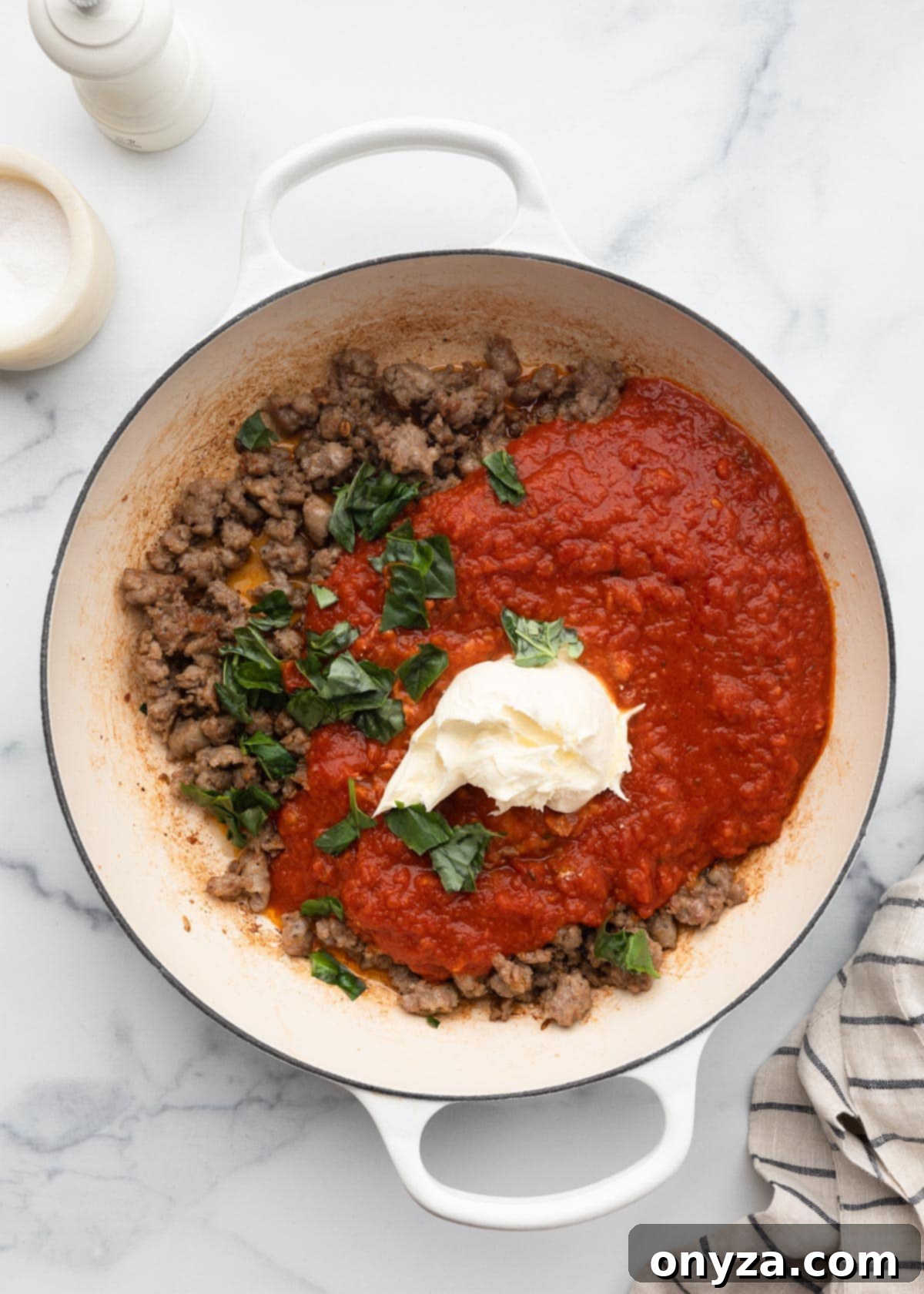
After the mascarpone has melted, take a moment to taste the sauce and adjust the seasoning as needed. The exact flavor profile will vary depending on the specific marinara and sausage brands you’ve used. You might find it benefits from a pinch of salt, a grind of fresh black pepper, a dash of garlic powder, or a sprinkle of Italian seasoning to enhance its natural flavors. For those who appreciate a little warmth, a sprinkle of crushed red pepper flakes can add a delightful kick.
Choosing the Best Store-Bought Marinara
When selecting a store-bought marinara, prioritize brands with a clean, simple ingredient list. Look for sauces that primarily feature quality Italian tomatoes (peeled or pureed), olive oil, garlic and/or onions, and classic herbs like basil and oregano. Our personal favorites for consistently great flavor are Carbone (the brand often pictured here) and Rao’s Homemade. Both deliver exceptional taste that often requires little to no additional seasoning in this recipe.
For individuals with dietary sensitivities to garlic or onions, it’s worth noting that both Carbone and Rao’s offer excellent versions without these ingredients. Carbone’s is called Marinara Delicato, and Rao’s offers its Sensitive Marinara.
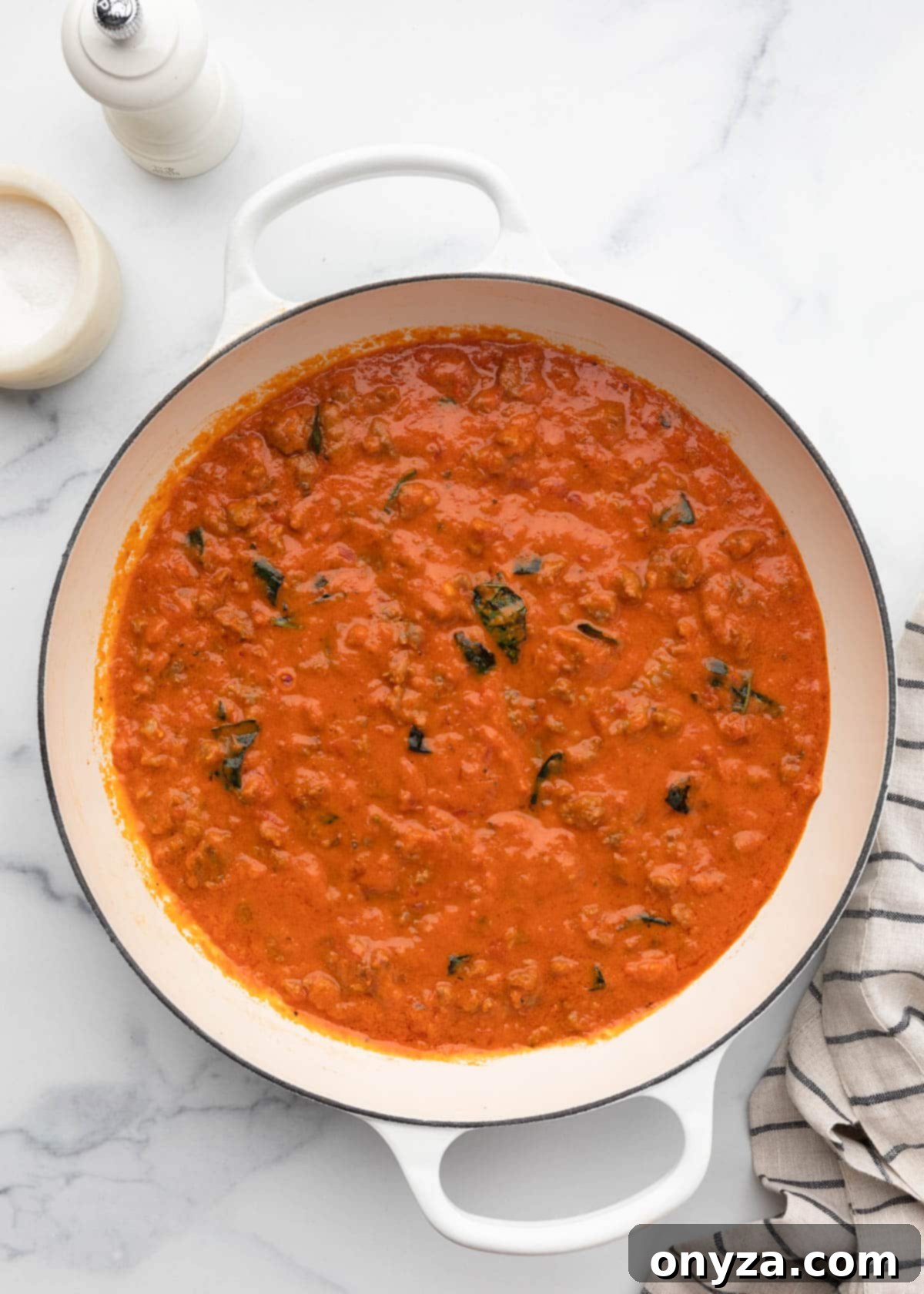
Step 3: Cooking the Tortellini to Al Dente Perfection
The next step involves preparing your tortellini. In a separate large pot, bring a generous amount of salted water to a gentle boil. Add the refrigerated tortellini or tortelloni and cook them just until they reach an al dente texture—meaning they should be firm yet tender to the bite. It’s crucial to avoid overcooking at this stage, as the pasta will continue to cook slightly in the oven. This ensures your tortellini remain delightfully intact and don’t become mushy.
Most refrigerated tortellini typically reach al dente in approximately 2 to 3 minutes. However, cooking times can vary significantly between brands, so always consult the package instructions for the most accurate guidance. For instance, the Kirkland Signature Five-Cheese Tortelloni from Costco (a family favorite) usually cooks in just 2 minutes, while Giovanni Rana Five Cheese Tortellini often requires closer to 3 minutes of boiling.
Tip: Handling Stuck Tortellini
If you notice the tortellini stuck together in the package, resist the urge to pull them apart forcefully. Doing so can cause the delicate pasta to tear, potentially leading to the loss of their delicious filling during boiling. They will naturally separate as they cook gently in the hot, circulating water.
As soon as the tortellini are perfectly al dente, quickly reserve about 1/4 cup of the starchy cooking water, then drain the pasta thoroughly into a colander. This reserved pasta water will be a secret weapon for achieving the ideal sauce consistency.
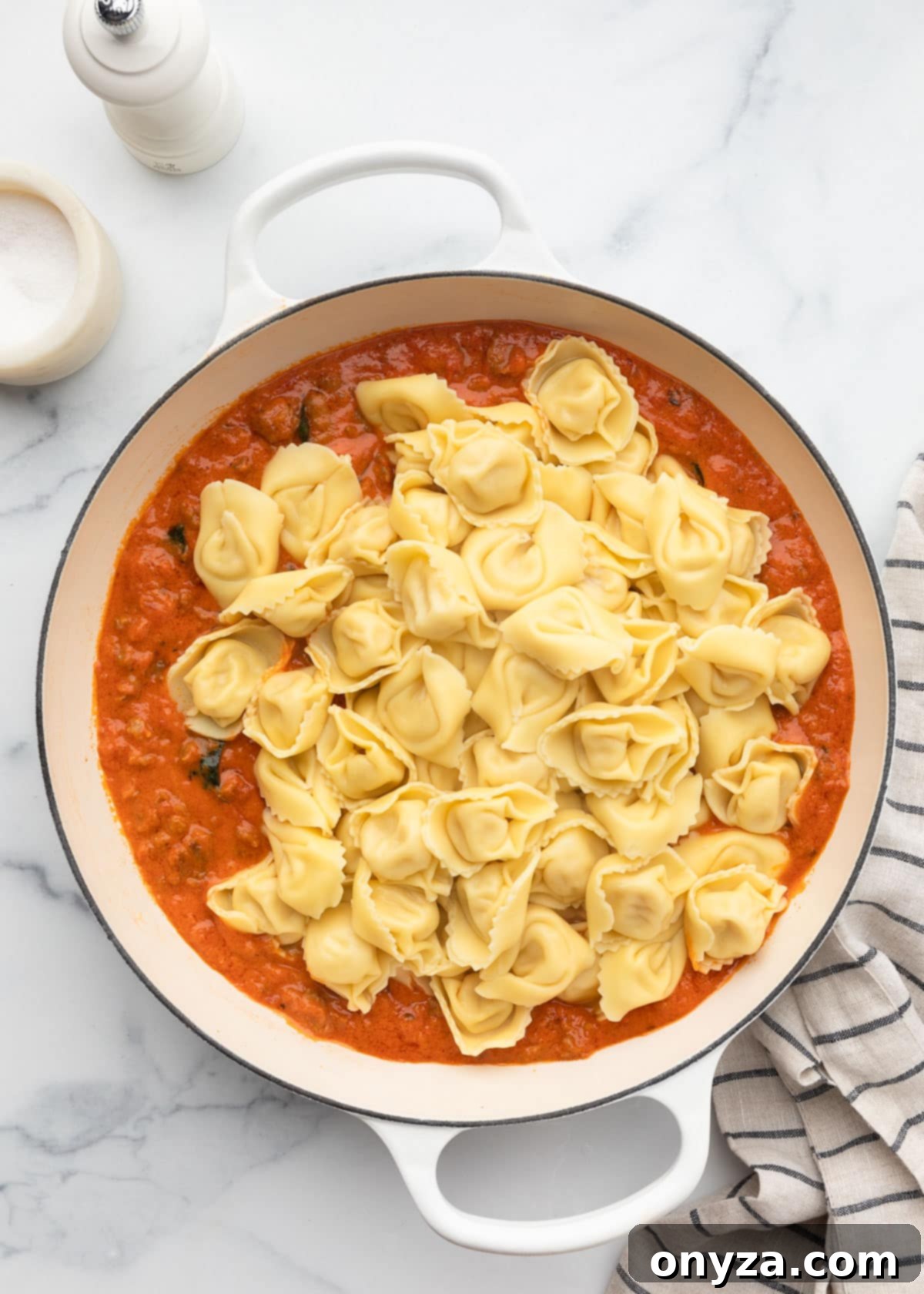
Why Pre-Boil the Tortellini?
Given how quickly fresh tortellini cooks, you might wonder why we don’t simply add them uncooked directly to the sauce and bake. While this seems like a step-saver, our tests have shown inconsistent results across different pasta brands.
When baking uncooked tortellini, sometimes they turned out perfectly tender, but other times, they were disappointingly chewy. More importantly, baking raw tortellini often led to issues with the sauce itself. Some batches would dry out excessively because the pasta absorbed too much liquid, while others ended up too loose or watery.
By giving the tortellini a head start with a quick boil, you gain greater control over the final texture, ensuring perfectly cooked pasta no matter the brand. Yes, it means an extra pot to wash, but the superior and consistent results are well worth the minor inconvenience!
Step 4: Assembling and Baking for Golden Perfection
Now, it’s time to bring everything together for its final transformation in the oven. If you’re using an oven-safe skillet that is also deep enough (like a Le Creuset Sauteuse, for example), you can conveniently assemble and bake the tortellini directly in that same pan. Otherwise, lightly oil a 3- to 3.5-quart baking dish (a standard 13×9-inch pan works perfectly) with olive oil or a cooking spray.
Gently fold the cooked tortellini into the prepared sausage and marinara sauce. Add just a splash of the reserved pasta water—about 2 to 4 tablespoons. This starchy pasta water plays an important role: it helps prevent the dish from drying out during baking and also allows the sauce to cling beautifully to each piece of tortellini, ensuring every bite is flavorful.

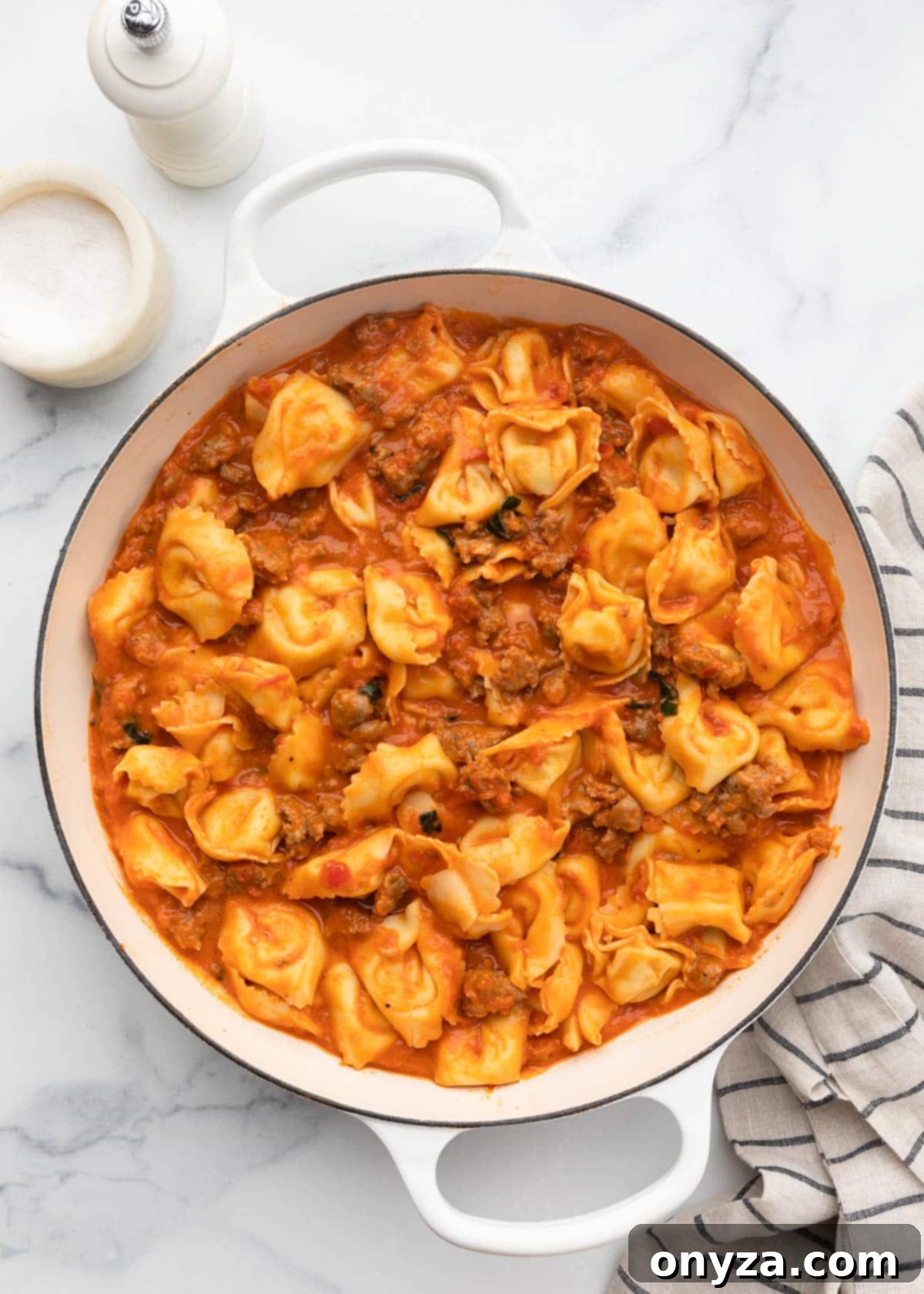
Transfer the combined mixture into your prepared baking dish. Generously top it with shredded whole-milk mozzarella cheese. For an extra layer of savory depth and a subtle smoky nuance, our family absolutely loves to use a blend of mozzarella and smoked provolone cheese. Finish with a sprinkle of finely grated Parmigiano Reggiano for that authentic Italian touch.
Cover the baking dish tightly with aluminum foil and bake in your preheated oven at 350°F (175°C) for 20–25 minutes. The goal during this phase is to ensure the casserole is thoroughly heated through and bubbling around the edges. After this initial bake, carefully remove the foil and return the dish to the oven for an additional 5 minutes to allow the cheese to melt fully and become beautifully gooey. For a truly golden-brown, irresistible crust, you can briefly broil the dish for 1–2 minutes. Keep a very close watch during broiling, as cheese can burn quickly!
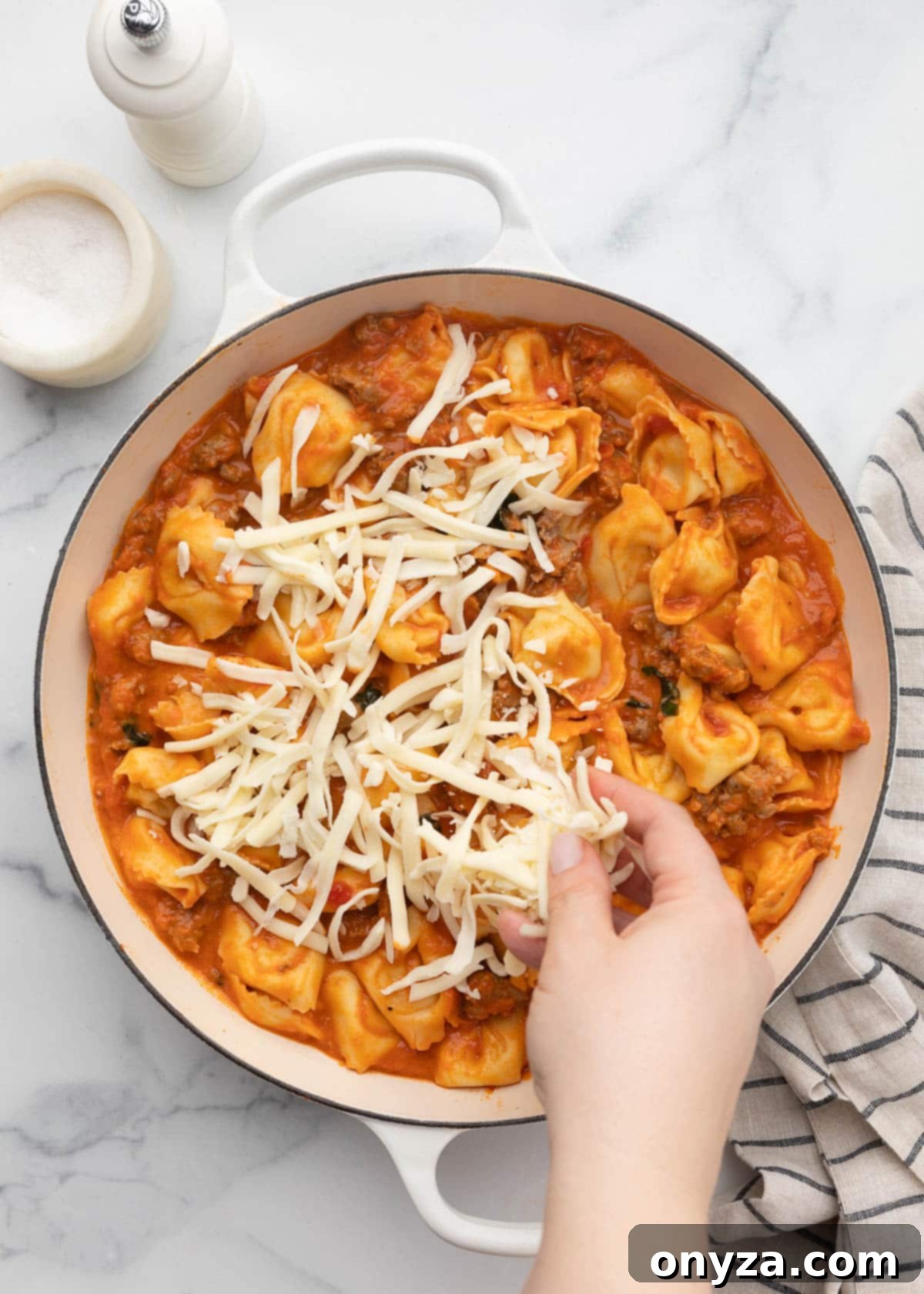
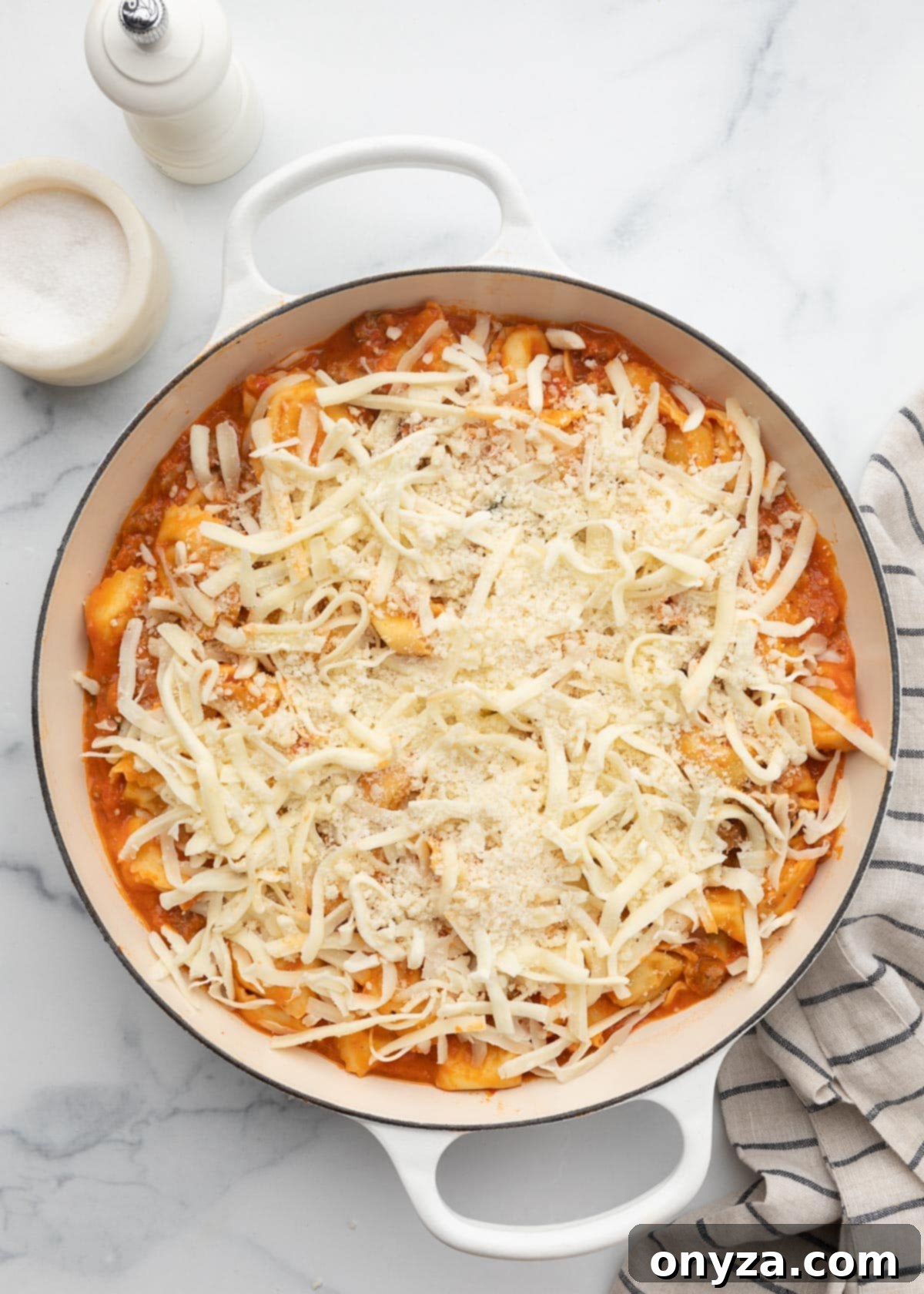
Serving Baked Tortellini with Sausage: The Perfect Italian Meal Experience
Once your Baked Tortellini with Sausage emerges from the oven, bubbling and golden, allow it to stand for a couple of minutes before serving. This brief resting period helps the melted cheese settle, making it much easier to scoop out clean, appealing portions. For a vibrant, fresh finishing touch, we love to garnish the dish with a sprinkle of extra fresh basil leaves, julienned or torn, which adds both color and an aromatic lift.
In our family, spice preferences vary widely, so we typically keep the main dish mild and offer crushed red pepper flakes on the side. This thoughtful addition allows each person to customize their own serving to be as spicy (or not spicy) as they desire, ensuring everyone enjoys their meal to the fullest.
To truly complete your Italian feast, serve your Baked Tortellini with Sausage alongside warm, crusty Italian bread, soft focaccia, or classic garlic bread. These breads are perfect for soaking up every last drop of the delectable sauce from the bottom of your bowl – a truly satisfying experience!
Given the richness and heartiness of this pasta bake, we typically balance the meal with a simple, fresh garden salad dressed with a bright vinaigrette. Our Balsamic Vinaigrette is a particular favorite for its tangy complement. Alternatively, a light arugula salad with its peppery bite or a traditional Caesar salad, complete with crunchy croutons, would also be excellent choices to round out this comforting meal.
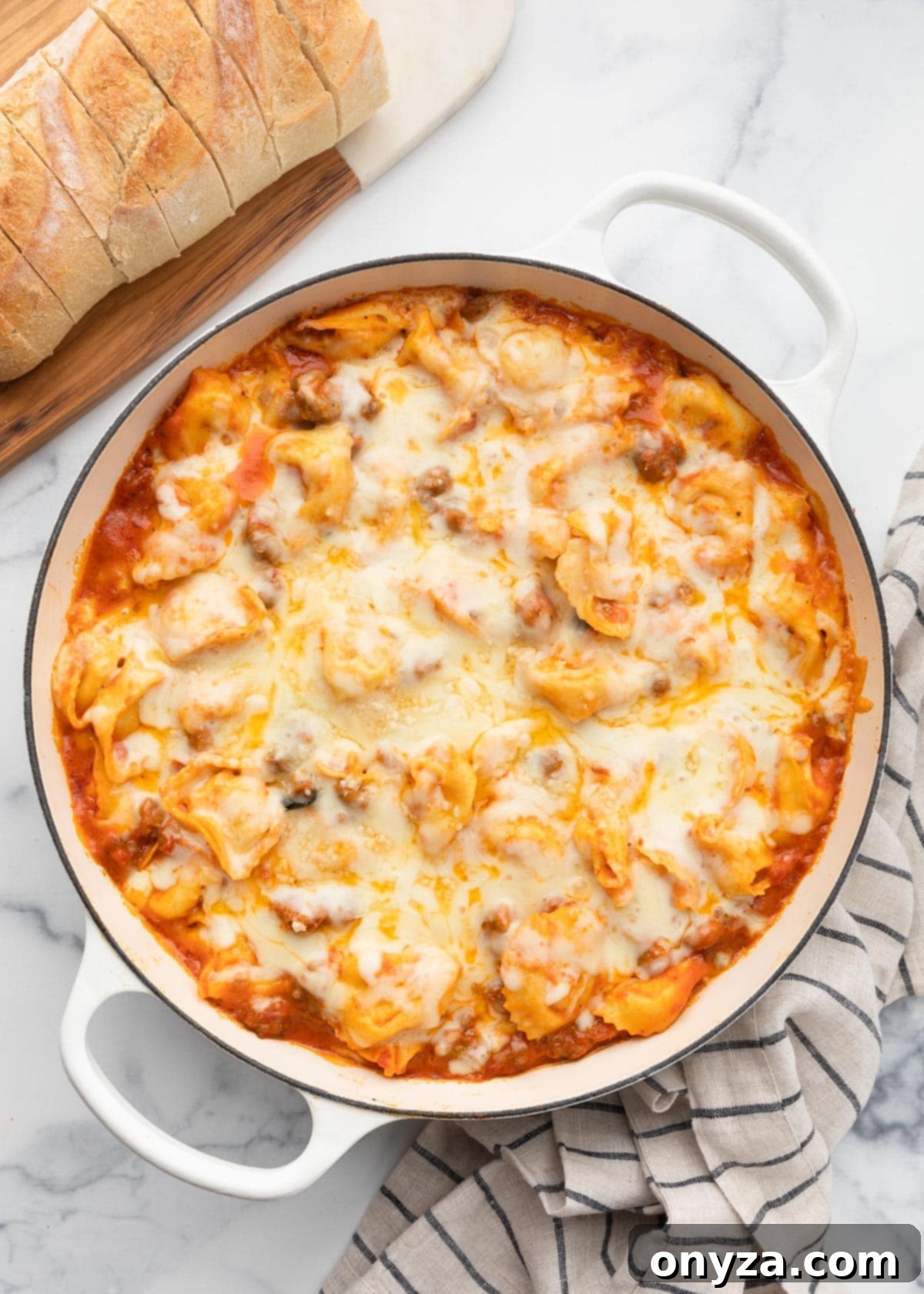
Storing and Reheating: Enjoying Your Leftovers
While this dish is undeniably at its best enjoyed fresh from the oven, any leftovers of your Baked Tortellini with Sausage can be stored in the refrigerator for a delightful meal later. Ensure the baked tortellini cools completely to room temperature before transferring it to an airtight container. For food safety, make sure to move it to the fridge within two hours of cooking. Leftovers will keep well for up to 3-4 days.
We generally do not recommend freezing this dish. The mascarpone in the sauce, being a delicate dairy product, has a tendency to separate and can become unpleasantly gritty in texture once defrosted and reheated, compromising the creamy quality of the sauce.
To reheat in the oven: For best results, transfer your leftover tortellini to an oven-safe baking dish. Cover it tightly with foil to retain moisture and bake at 350°F (175°C) for approximately 15-20 minutes, or until it’s thoroughly heated through and bubbling gently.
To reheat in the microwave: Place a single portion of the tortellini in a microwave-safe dish and cover it with a vented microwave-safe lid. Heat on medium power for about 1 minute, then stir gently. Continue heating in 30-second intervals, stirring between each interval, until the dish is warmed through. This usually takes about 2–3 minutes, depending on the portion size and microwave wattage.
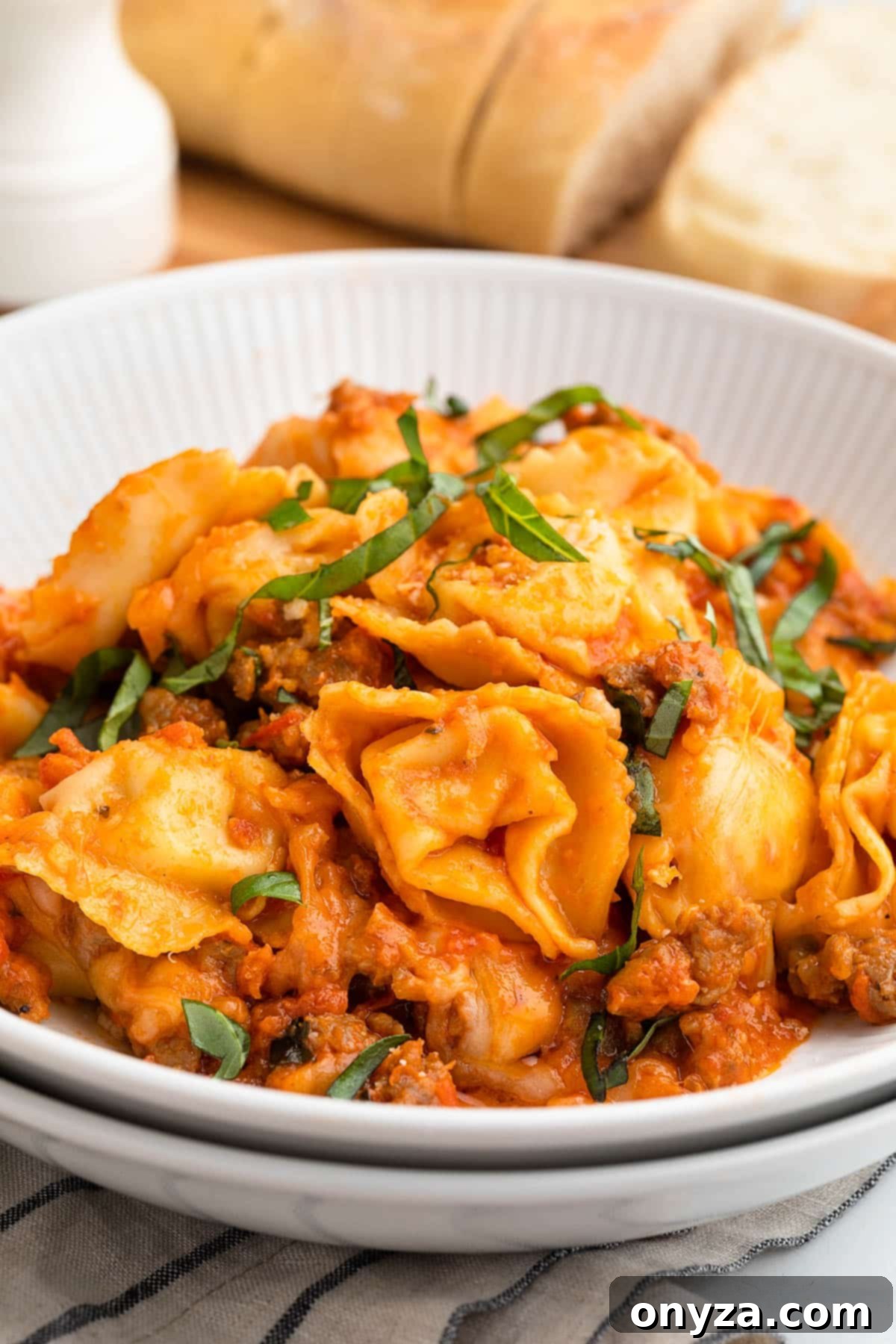
Reheating Tips for Best Results
- When reheating, especially in the microwave or oven, consider adding a small splash of water or cream (milk works too) to the dish. This helps prevent the sauce from drying out and can restore some of its original creamy texture.
- Be aware that the tortellini will naturally become softer after being refrigerated and reheated than when they were first cooked. To prevent them from becoming mushy, try not to overheat them. The reheated dish should reach an internal temperature of 165°F (74°C) for optimal food safety.
- To refresh the cheesy topping, sprinkle a little extra shredded mozzarella or Parmigiano Reggiano before reheating in the oven, or during the last 30 seconds of microwaving. This adds a delightful fresh melty layer.
Delicious Variations & Customizations for Your Tortellini Bake
One of the joys of this Baked Tortellini with Sausage recipe is its incredible versatility. Feel free to experiment with different ingredients and customize it to your family’s preferences or what you have on hand:
- Add More Vegetables: Boost the nutritional value and texture by incorporating your favorite vegetables. Sautéed spinach, diced zucchini, sliced mushrooms, or finely chopped bell peppers can be added to the skillet with the sausage (or after draining the fat) to cook down before the marinara.
- Protein Swaps: While Italian sausage is a classic, you can easily swap it out. Try ground beef, ground turkey, or even cooked shredded chicken. For a vegetarian option, use a plant-based Italian sausage alternative, or enhance the dish with sautéed mushrooms, lentils, or cannellini beans.
- Cheese Adventures: Beyond mozzarella and Parmigiano Reggiano, consider other cheeses. A layer of ricotta cheese beneath the mozzarella adds an extra creamy dimension, while provolone, Fontina, or even a sharper Pecorino Romano could be mixed in for different flavor profiles.
- Spice It Up or Tone It Down: Adjust the heat by increasing or decreasing the amount of hot Italian sausage or crushed red pepper flakes. For a milder flavor, ensure you use only sweet Italian sausage and omit the red pepper.
- Herbacious Touches: Fresh basil is wonderful, but you can also mix in fresh oregano, parsley, or even a hint of fresh thyme for additional aromatic complexity. Dried Italian seasoning can be added to the sauce if fresh herbs aren’t available.
- A Touch of Wine: Deglaze the pan with a splash of dry red wine after browning the sausage and before adding the marinara. Let it simmer until almost evaporated for an added layer of sophisticated flavor.
More Italian and Italian-American Dinner Recipes You’ll Love
If you’ve enjoyed this comforting baked pasta dish, we invite you to explore more of our beloved Italian and Italian-American inspired recipes. These dishes are perfect for family dinners, entertaining guests, or simply satisfying your craving for rich, authentic flavors:
- Chicken Marsala
- Italian Wedding Soup
- Creamy Pork Chops Marsala
- Chicken Milanese
- Creamy Chicken Gnocchi Soup
- Linguine with Clams
- Easy Shrimp Scampi
Baked Tortellini with Sausage
By: Amanda Biddle
Baked Tortellini with Sausage is a rich, flavorful dinner packed with tender pasta, savory sauce, and gooey cheese. This easy-to-make dish is ready in under an hour, making it perfect for busy weeknights or a comforting family dinner.
Prep Time: 20 minutes
Cook Time: 30 minutes
Resting Time: 5 minutes
Total Time: 55 minutes
Servings: 6 servings
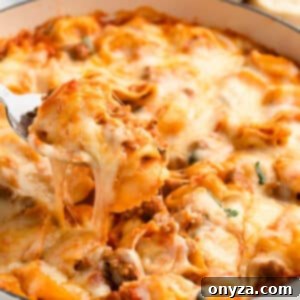
Ingredients
- 1 pound sweet Italian sausage, casings removed
- 1 tablespoon regular olive oil
- 24 ounces prepared marinara sauce (such as Carbone or Rao’s)
- ½ cup mascarpone cheese
- 5 to 6 large fresh basil leaves, torn (plus additional for garnish)
- 1-1/2 pounds refrigerated cheese tortellini or tortelloni, 24 ounces (we love the Kirkland 5 Cheese Tortelloni from Costco)
- 1-1/2 to 2 cups shredded whole milk mozzarella (or a blend of mozzarella and smoked provolone)
- ¼ cup finely grated Parmigiano Reggiano
Instructions
- Preheat your oven to 350°F (175°C) with the rack in the middle position. Lightly oil a 3- to 3.5-quart baking dish, such as a 13×9 inch pan. (See note below for using an oven-safe skillet.)
- Cook the Sausage: Heat 1 tablespoon of olive oil in a large skillet over medium-high heat. Add the sausage meat and cook, breaking it into crumbles with a wooden spoon or meat masher, until fully cooked through and nicely browned, about 8–10 minutes. Carefully drain any excess fat from the pan.
- Prepare the Sauce: Reduce the heat to low. Stir in the marinara sauce, mascarpone cheese, and torn basil leaves with the browned sausage. Cook, stirring continuously, for just a couple of minutes until the mascarpone is fully melted and smoothly integrated into the sauce. (See note below for seasoning tips.) Remove the skillet from the heat.
- Cook the Tortellini: Bring a large pot of generously salted water to a gentle boil. Add the tortellini and cook just until they are al dente (firm yet tender), typically 2–3 minutes for most refrigerated tortellini brands. Drain the tortellini well, making sure to reserve about 1/4 cup of the starchy pasta water.
- Combine Pasta and Sauce: Gently toss the drained tortellini into the prepared creamy sausage marinara sauce. Add 2–4 tablespoons of the reserved pasta water to help the sauce cling beautifully to the pasta and prevent drying during baking.
- Assemble the Dish: Transfer the coated tortellini and sauce mixture to the prepared baking dish (or continue in the oven-safe skillet). Evenly sprinkle the top with the shredded mozzarella cheese (adjust the amount based on your preference and dish size) and the finely grated Parmigiano Reggiano.
- Bake: Cover the baking dish tightly with aluminum foil and bake for 20–25 minutes, or until the casserole is hot and bubbly throughout. Remove the foil and bake for an additional 5 minutes to allow the cheese to fully melt. For a golden, slightly crisped top, you can broil for an extra 1–2 minutes, watching carefully to prevent burning.
- Serve: Let the dish rest for a few minutes before serving. Garnish with additional fresh basil if desired, and serve with crushed red pepper flakes on the side for those who enjoy a little extra heat.
Notes
Baking Dish: If the skillet or pan you used to brown the sausage is oven-safe and has sufficient capacity (e.g., a 3.5-quart Sauteuse), you can directly assemble and bake the tortellini in that same pan. There’s no need to oil it in this case. Otherwise, simply transfer the tortellini mixture to a separate baking dish as instructed.
Seasoning the Sauce: The flavor of your finished sauce will largely depend on the specific brands of marinara and sausage you’ve chosen. Always taste the sauce before adding the tortellini. If it needs a flavor boost, consider enhancing it with a pinch of Italian seasoning, garlic powder, salt, and/or fresh black pepper. For a touch of warmth, a sprinkle of red pepper flakes works wonders.
This recipe was inspired by Giada DeLaurentiis’ Cheesy Baked Tortellini.
Nutrition Estimate
Serving: 0.16 recipe | Calories: 826kcal | Carbohydrates: 57g | Protein: 38g | Fat: 49g | Saturated Fat: 21g | Polyunsaturated Fat: 3g | Monounsaturated Fat: 13g | Cholesterol: 144mg | Sodium: 1835mg | Potassium: 554mg | Fiber: 6g | Sugar: 8g | Vitamin A: 993IU | Vitamin C: 10mg | Calcium: 408mg | Iron: 5mg
Nutrition information is automatically calculated and should only be used as an approximation. Actual values may vary.
Please note that our recipes have been developed using the US Customary measurement system and have not been tested for high altitude/elevation cooking and baking. Adjustments may be necessary for different environments.
